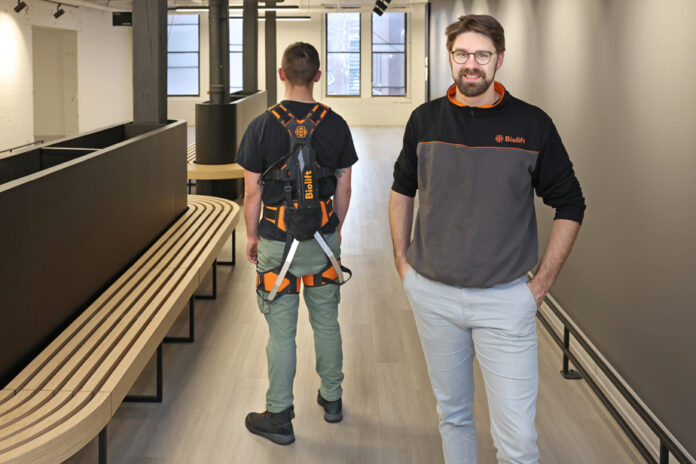A 3.5 kg portable structure attached to the back which reduces muscular effort. This “exoskeleton” intended for construction workers stores mechanical energy with compressed air springs when you bend over, and redistributes it when you get up, reducing back strain by at least 30% for a weight up to 27 kg.
Starting in 2013, four mechanical engineering students at Polytechnique Montréal – Samuel Lecours, Laurent Blanchet, Guillaume Gaudet and Mathieu Ramananarivo – developed various exoskeleton prototypes. “We were working on hand prostheses, exoskeletons for walking, for shoulders, everyone had their own projects,” says Laurent Blanchet. But in the background of all that, we had a bit of an entrepreneurial idea too. »
Biolift was finally founded in March 2019 with a more specific objective: to bring to market an exoskeleton to protect the backs of workers called upon to lift heavy loads, particularly on construction sites.
In particular thanks to paternal contacts, the founders of Biolift met managers of Eurovia Québec, a subsidiary of the French group Vinci, one of the main global players in construction.
“They had major problems with their curb and sidewalk teams, injuries to their backs, wrists, shoulders,” explains the CEO. That’s when the project of developing the exoskeleton was proposed. They helped us from afar. It allowed us to have a first client, it’s so important. »
The first exoskeleton was sold in 2021. Biolift today has around twenty customers, mainly in Quebec, and employs ten people. Three of the four founders are still part of the team, only Guillaume Gaudet left in June 2022.
The heart of the structure of the exoskeleton designed by Biolift is made of aluminum, a lightweight material that has the strength and flexibility to support the weights to be carried and human muscular strength. Everything is assembled by Biolift from components produced “90% by subcontractors in Quebec,” specifies Mr. Blanchet.
No motors or electronic parts, they are springs which store muscular effort and redistribute it “intelligently for certain tasks”. “Nothing is lost, nothing is created: we take the energy of the human body and we move it. »
The result is that this exoskeleton can lift weights up to 60 pounds with a significant reduction in worker effort – at least 30%, according to preliminary tests. Biolift takes care of adjustments and minimal training to use the exoskeleton.
The exoskeleton is sold to companies, not individuals, at a cost ranging from $3,000 to $5,000 per unit.
Finding the right elements, durable yet flexible, was a good design challenge. “If I weigh 80 kg, just by the weight of my torso, I can create tensions of 40 kg. We had tested half-inch pieces of steel which ended up twisting. We ended up, with aluminum, finding the right way to place it in the right axes. »
Proposing something new in the construction industry, “a place where change is not easy,” is a challenge. We had to determine the market, “target the right companies, the right professions, find the right market where we have the most impact. The first few years were a lot of exploration.” In addition to construction sites, we found a niche in landscaping, particularly for the laying of paving stones.
After Quebec – and a few presences in Ottawa – Biolift wants to tackle the entire North American market starting next year. “We are registered for all the trade fairs, all the upcoming conferences, we are going to show this to everyone,” announces the CEO.
For the moment, partnerships with companies are Biolift’s business model. They are not closed, “in the longer term”, to offering the exoskeleton to consumers.















